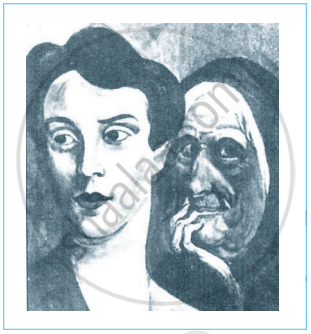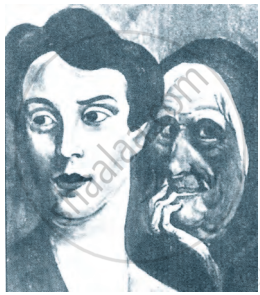Advertisements
Advertisements
Question
Explain the characteristics of indirect techniques that are used to assess personality. Describe any two such tests.
Solution
The techniques of personality assessment described so far are known as direct techniques, because they tend to rely on information directly obtained from the person who clearly knows that her/his personality is being assessed. In these situations, people generally become self-conscious and hesitate to share their private feelings, thoughts, and motivations. When they do so, they often do it in a socially desirable manner.
Indirect techniques/projective techniques are methods of assessment based on the psychoanalytic theory.
Projective techniques were developed to assess unconscious motives and feelings. These techniques are based on the assumption that a less structured or unstructured stimulus or situation will allow the individual to project her/his feelings, desires, and needs onto that situation. These projections are interpreted by experts. A variety of projective techniques have been developed; they use various kinds of stimulus materials and situations for assessing personality. Some of them require reporting associations with stimuli (e.g., words, inkblots), some involve story writing around pictures, some require sentence completions, some require expression through drawings, and some require the choice of stimuli from a large set of stimuli.
- The stimuli are relatively or fully unstructured and poorly defined.
- The person being assessed is usually not told about the purpose of the assessment and the method of scoring and interpretation.
- The person is informed that there are no correct or incorrect responses.
- Each response is considered to reveal a significant aspect of personality.
- Scoring and interpretation are lengthy and sometimes subjective.
The Thematic Apperception Test (TAT)
This test was developed by Morgan and Murray. It is a little more structured than the Inkblot test. The test consists of 30 black and white picture cards and one blank card. Each picture card depicts one or more people in a variety of situations. Each picture is printed on a card. Some cards are used with adult males or females. Others are used with boys or girls. Still, others are used in some combinations. Twenty cards are appropriate for a subject, although a lesser number of cards (even five) have also been successfully used. An example of a TAT card is given in Figure.

An Illustration Showing the Drawing of a Card of TAT.
Sentence Completion Test
This test makes use of a number of incomplete sentences. The starting part of the sentence is first presented and the subject has to provide an ending to the sentence. It is held that the type of endings used by the subjects reflects their attitudes, motivation, and conflicts. The test provides subjects with several opportunities to reveal their underlying unconscious motivations. A few sample items of a sentence completion test are given below.
- My father ______.
- My greatest fear is ______.
- The best thing about my mother is ______.
- I am proud of ______.
APPEARS IN
RELATED QUESTIONS
What is meant by structured personality tests? Which are the two most widely used structured personality tests?
A teacher might assume that a well-behaved student is also bright and motivated before they have objectively evaluated the student's capacity in these areas. Identify the phenomenon.
Two statements are given in the question below as Assertion (A) and Reasoning (R).
Assertion (A): Behavioral ratings suffer from major limitations like acquiescence.
Reason (R): Raters have a tendency to place individuals in the middle of a scale by avoiding extreme positions.
Refer to the picture given below and answer the question by choosing the most appropriate option:

Which of the following is NOT a characteristic of this test?
Refer to the picture given below and answer the question by choosing the most appropriate option:

Identify the name of the test from the options given below.
Refer to the picture given below and answer the question by choosing the most appropriate option:

Which of the following statements are NOT true of this test?
- In the first phase, called performance proper, the subjects are shown the cards and are asked to tell what they see in each of them.
- The second phase is called inquiry.
- Each picture card depicts one or more people in a variety of situations.
- The subject is asked to tell a story describing the situation presented in the picture.
Choose the correct option:
If an individual is fat, soft and round along with a temperament that is relaxed and sociable, then he/she is said to have the characteristics of an ______.
Gurmeet was given a personality test to assess how he expresses aggression in the face of a frustrating situation. Identify the test most suitable for this.
Which of the following is a projective technique for assessing personality?
The Thematic Apperception Test (TAT) was developed by ____________.
Which is not the part of "on the job training"?
A field experiment at the Bronx Zoo illustrated the potential importance of ______ indicating that an individual has legitimate authority. Fill in the blank from given below.
Psychologists who follow the Freudian theories of personality are most likely to use ______ for personality assessment.
The personality assessment technique that is commonly used to gather data from people who know the client very well is ______.
The process of blocking or thwarting needs causes frustration in human beings.
The most important scale for the measurement of psychological traits is ______
Which technique is used by T.A.T.?
Who used ink-block test first?
The term multi-dimensional is related to ______
Which of the following is most widely used as projective techniques?
Dismissing anxiety provoking behaviours or thoughts from unconscious is known as
Sixteen Personality Factor (16 PF) Questionnaire was developed by ______.
The Thematic Apperception Test (TAT) was developed by ______.
Why is behavioural analysis conducted to overcome stress?
- To find malfunctioning behaviour.
- To find the consequent operations of the adaptive behaviour.
- To identify the antecedents of faulty learning.
- To identify factors that maintain faulty learning.
